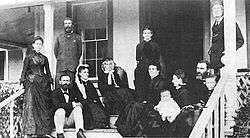Aylmer Francis Robinson
| Aylmer Francis Robinson | |
|---|---|
 Sinclair family at Makaweli House, 1893. The young Aylmer is on his mother's lap. | |
| Born |
May 6, 1888 Makaweli, Kauaʻi |
| Died | April 3, 1967 (aged 78) |
| Occupation | Planter, Rancher |
| Parent(s) |
Aubrey Robinson Alice Gay |
Aylmer Francis Robinson (1888–1967) was an owner of a large ranch that encompassed an island in the Hawaiian Islands.
Life
Aylmer Francis Robinson was born May 6, 1888 at the Robinson family estate in Makaweli on the island of Kauaʻi during the Kingdom of Hawaii. His father was Aubrey Robinson (1853–1936) and mother was Alice Gay Robinson who was his father's cousin. This made him double great-grandson of family matriarch Elizabeth McHutchison Sinclair (1800–1892).[1] Besides various properties on Kauaʻi, the family owned the entire island of Niʻihau since 1864.[2]
He was sent to the St. Mathew's Military School in Burlingame, California, and then graduated from Harvard University in 1910.[3] He returned and worked at a sugarcane plantation in Waipahu, Hawaii in 1911.[1]
He became manager of the Makaweli ranch in 1912, and then a partner in the Gay and Robinson business, formed by his father and uncle Francis Gay.[1] In 1922 he took over from his father who retired from managing the ranch on Niʻihau. He was scheduled for one of his weekly visits when a Japanese warplane crashed on the island after the attack on Pearl Harbor in 1941. In what became known as the Niihau Incident, the pilot was captured, then freed by one of Robinson's Japanese employees. Robinson led American soldiers to the island, where the remains of both the pilot and aircraft were recovered.[4]
A species of palm tree, Pritchardia aylmer-robinsonii was named for him by botanist Harold St. John in 1947.[5] Although never active himself in politics, he identified himself with the Hawaii Republican Party, and residents of the family island voted solidly Republican even after the rest of the territory and later the state of Hawaii, turned Democratic.[6] He never married, so when he died on April 3, 1967 the family estates went to his youngest brother Lester.[2] The Gay & Robinson sugar business shut down in 2009 after 120 years.[7]
Family tree
Sinclair-Robinson family tree | ||||||||||||||||||||||||||||||||||||||||||||||||||||||||||||||||||||||||||||||||||||||||||||||||||||||||||||||||||||||||||||||||||||||||||||||||||||||||||||||||||||||||||||||||||||||||||||||||||||||||||||||||||||||||||||||||||||||||||||||||||||||||||||||||||||||||||||||||||||||||||||||||||||||||||||||||||||||||||||||||||||||||||||||||||||||||||||||
|---|---|---|---|---|---|---|---|---|---|---|---|---|---|---|---|---|---|---|---|---|---|---|---|---|---|---|---|---|---|---|---|---|---|---|---|---|---|---|---|---|---|---|---|---|---|---|---|---|---|---|---|---|---|---|---|---|---|---|---|---|---|---|---|---|---|---|---|---|---|---|---|---|---|---|---|---|---|---|---|---|---|---|---|---|---|---|---|---|---|---|---|---|---|---|---|---|---|---|---|---|---|---|---|---|---|---|---|---|---|---|---|---|---|---|---|---|---|---|---|---|---|---|---|---|---|---|---|---|---|---|---|---|---|---|---|---|---|---|---|---|---|---|---|---|---|---|---|---|---|---|---|---|---|---|---|---|---|---|---|---|---|---|---|---|---|---|---|---|---|---|---|---|---|---|---|---|---|---|---|---|---|---|---|---|---|---|---|---|---|---|---|---|---|---|---|---|---|---|---|---|---|---|---|---|---|---|---|---|---|---|---|---|---|---|---|---|---|---|---|---|---|---|---|---|---|---|---|---|---|---|---|---|---|---|---|---|---|---|---|---|---|---|---|---|---|---|---|---|---|---|---|---|---|---|---|---|---|---|---|---|---|---|---|---|---|---|---|---|---|---|---|---|---|---|---|---|---|---|---|---|---|---|---|---|---|---|---|---|---|---|---|---|---|---|---|---|---|---|---|---|---|---|---|---|---|---|---|---|---|---|---|---|---|---|---|---|---|---|---|---|---|---|---|---|---|---|---|---|---|---|---|---|---|---|---|---|---|---|---|---|---|---|---|---|---|---|---|---|---|---|
| ||||||||||||||||||||||||||||||||||||||||||||||||||||||||||||||||||||||||||||||||||||||||||||||||||||||||||||||||||||||||||||||||||||||||||||||||||||||||||||||||||||||||||||||||||||||||||||||||||||||||||||||||||||||||||||||||||||||||||||||||||||||||||||||||||||||||||||||||||||||||||||||||||||||||||||||||||||||||||||||||||||||||||||||||||||||||||||||
| Notes:
| ||||||||||||||||||||||||||||||||||||||||||||||||||||||||||||||||||||||||||||||||||||||||||||||||||||||||||||||||||||||||||||||||||||||||||||||||||||||||||||||||||||||||||||||||||||||||||||||||||||||||||||||||||||||||||||||||||||||||||||||||||||||||||||||||||||||||||||||||||||||||||||||||||||||||||||||||||||||||||||||||||||||||||||||||||||||||||||||
See also
References
- 1 2 3 John William Siddall, ed. (1921). Men of Hawaii: being a biographical reference library, complete and authentic, of the men of note and substantial achievement in the Hawaiian Islands. Honolulu Star-Bulletin. p. 341.
- 1 2 John R. K. Clark (1990). Beaches of Kaua'i and Ni'ihau. University of Hawaii Press. p. 89. ISBN 978-0-8248-1260-7.
- ↑ Class of 1910 Secretary's third report. Harvard College. March 1917.
- ↑ Edward R. Stepien (1988). Ni'ihau: a brief history. University of Hawaii at Manoa.
- ↑ "Pritchardia aylmer-robinsonii (Arecaceae)". Meet the Plants. National Tropical Botanical Garden. Retrieved October 26, 2010.
- ↑ Gavan Daws; Timothy Heap (October 1963). "Niihau, a shoal of time: For a century Hawaii's westernmost island has stubbornly resisted the tides of change". American Heritage magazine. Retrieved October 26, 2010.
- ↑ Dennis Fujimoto (October 26, 2009). "Gay & Robinson prepares to 'move on'". Garden Island News. Retrieved October 26, 2010.
External links
- "The Sinclair family". web site. Eric A. Knudsen trust. Archived from the original on February 17, 2011. Retrieved October 26, 2010. Photo of Sinclair-Robinson family from 1893
- "Aylmer Francis Robinson". web shots. Retrieved October 26, 2010. Family photo of Aylmer Robinson
- James Lansdale. "The Ni'ihau Zero Machine Gun Mystery". Japanese aircraft web site. Archived from the original on 29 October 2010. Retrieved October 26, 2010. Photos of Niihau incident